Essay on HRM Challenges: Managing Precariousness at the Workplace
VerifiedAdded on 2022/10/08
|7
|2224
|17
Essay
AI Summary
This essay delves into the challenges managers encounter while navigating precarious employment within the workplace. It begins by defining precarious work and its implications, including job insecurity and poor working conditions, and then explores the specific challenges faced by managers. These challenges include declining employee morale, the absence of adequate training and development programs, and the impact on employee mental health. The essay then offers recommendations for addressing these issues, such as implementing comprehensive training programs, providing fair rewards and recognition, and establishing effective performance management systems. The essay concludes by emphasizing the need for improved human resource management practices to support precarious workers, enhance their job satisfaction, and foster a more productive and supportive work environment. The essay also references key academic sources to support its arguments.
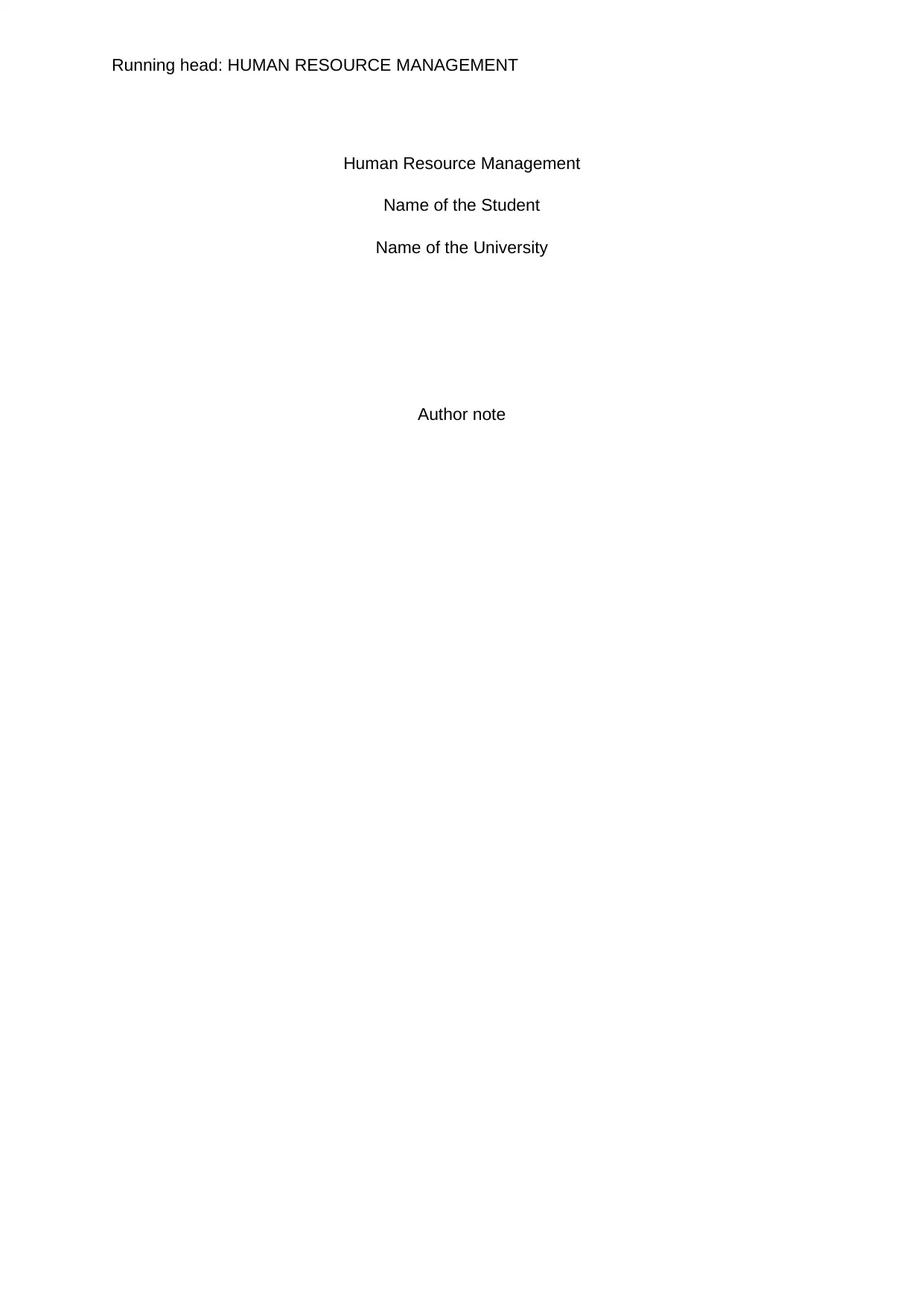
Running head: HUMAN RESOURCE MANAGEMENT
Human Resource Management
Name of the Student
Name of the University
Author note
Human Resource Management
Name of the Student
Name of the University
Author note
Paraphrase This Document
Need a fresh take? Get an instant paraphrase of this document with our AI Paraphraser
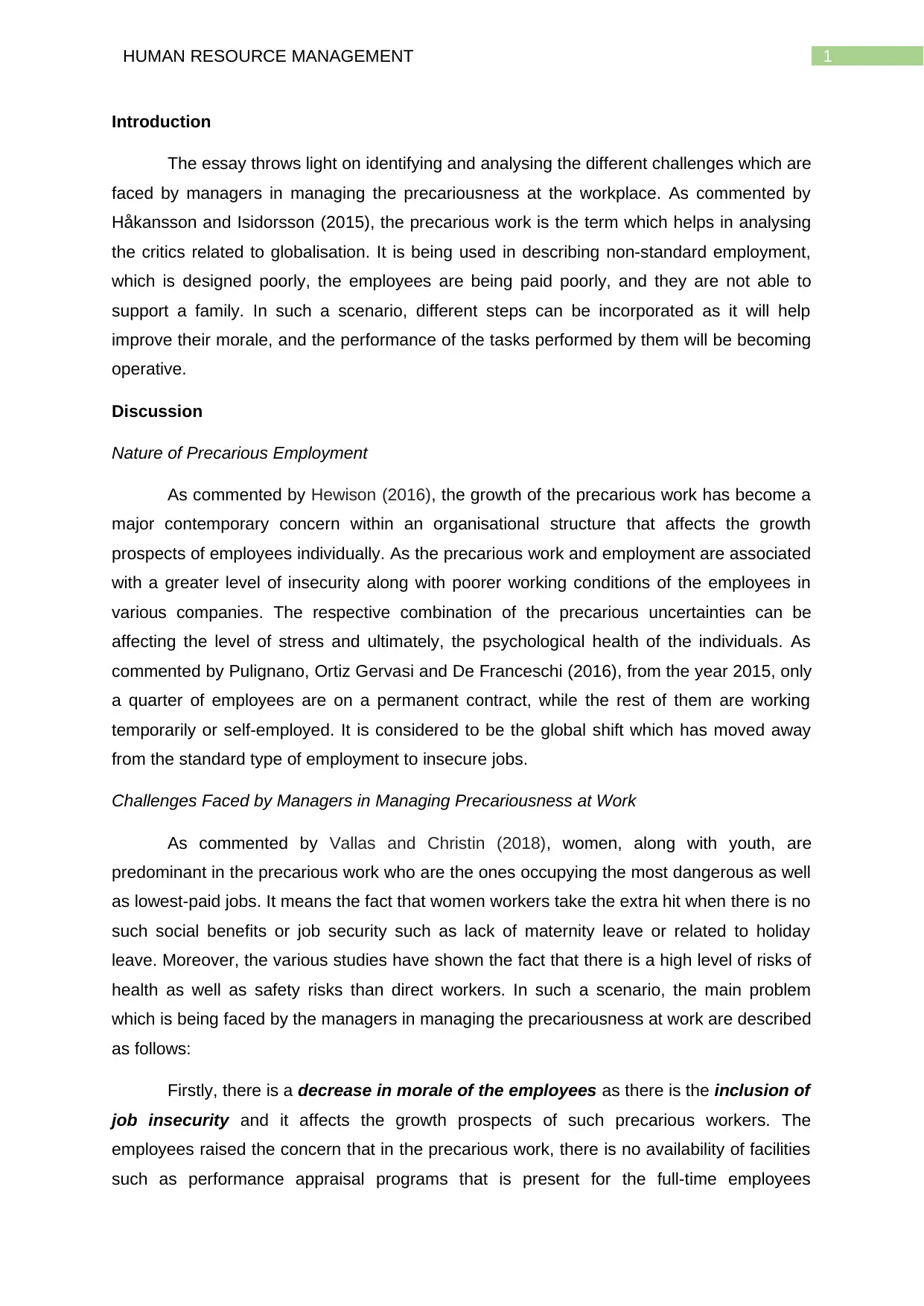
1HUMAN RESOURCE MANAGEMENT
Introduction
The essay throws light on identifying and analysing the different challenges which are
faced by managers in managing the precariousness at the workplace. As commented by
Håkansson and Isidorsson (2015), the precarious work is the term which helps in analysing
the critics related to globalisation. It is being used in describing non-standard employment,
which is designed poorly, the employees are being paid poorly, and they are not able to
support a family. In such a scenario, different steps can be incorporated as it will help
improve their morale, and the performance of the tasks performed by them will be becoming
operative.
Discussion
Nature of Precarious Employment
As commented by Hewison (2016), the growth of the precarious work has become a
major contemporary concern within an organisational structure that affects the growth
prospects of employees individually. As the precarious work and employment are associated
with a greater level of insecurity along with poorer working conditions of the employees in
various companies. The respective combination of the precarious uncertainties can be
affecting the level of stress and ultimately, the psychological health of the individuals. As
commented by Pulignano, Ortiz Gervasi and De Franceschi (2016), from the year 2015, only
a quarter of employees are on a permanent contract, while the rest of them are working
temporarily or self-employed. It is considered to be the global shift which has moved away
from the standard type of employment to insecure jobs.
Challenges Faced by Managers in Managing Precariousness at Work
As commented by Vallas and Christin (2018), women, along with youth, are
predominant in the precarious work who are the ones occupying the most dangerous as well
as lowest-paid jobs. It means the fact that women workers take the extra hit when there is no
such social benefits or job security such as lack of maternity leave or related to holiday
leave. Moreover, the various studies have shown the fact that there is a high level of risks of
health as well as safety risks than direct workers. In such a scenario, the main problem
which is being faced by the managers in managing the precariousness at work are described
as follows:
Firstly, there is a decrease in morale of the employees as there is the inclusion of
job insecurity and it affects the growth prospects of such precarious workers. The
employees raised the concern that in the precarious work, there is no availability of facilities
such as performance appraisal programs that is present for the full-time employees
Introduction
The essay throws light on identifying and analysing the different challenges which are
faced by managers in managing the precariousness at the workplace. As commented by
Håkansson and Isidorsson (2015), the precarious work is the term which helps in analysing
the critics related to globalisation. It is being used in describing non-standard employment,
which is designed poorly, the employees are being paid poorly, and they are not able to
support a family. In such a scenario, different steps can be incorporated as it will help
improve their morale, and the performance of the tasks performed by them will be becoming
operative.
Discussion
Nature of Precarious Employment
As commented by Hewison (2016), the growth of the precarious work has become a
major contemporary concern within an organisational structure that affects the growth
prospects of employees individually. As the precarious work and employment are associated
with a greater level of insecurity along with poorer working conditions of the employees in
various companies. The respective combination of the precarious uncertainties can be
affecting the level of stress and ultimately, the psychological health of the individuals. As
commented by Pulignano, Ortiz Gervasi and De Franceschi (2016), from the year 2015, only
a quarter of employees are on a permanent contract, while the rest of them are working
temporarily or self-employed. It is considered to be the global shift which has moved away
from the standard type of employment to insecure jobs.
Challenges Faced by Managers in Managing Precariousness at Work
As commented by Vallas and Christin (2018), women, along with youth, are
predominant in the precarious work who are the ones occupying the most dangerous as well
as lowest-paid jobs. It means the fact that women workers take the extra hit when there is no
such social benefits or job security such as lack of maternity leave or related to holiday
leave. Moreover, the various studies have shown the fact that there is a high level of risks of
health as well as safety risks than direct workers. In such a scenario, the main problem
which is being faced by the managers in managing the precariousness at work are described
as follows:
Firstly, there is a decrease in morale of the employees as there is the inclusion of
job insecurity and it affects the growth prospects of such precarious workers. The
employees raised the concern that in the precarious work, there is no availability of facilities
such as performance appraisal programs that is present for the full-time employees
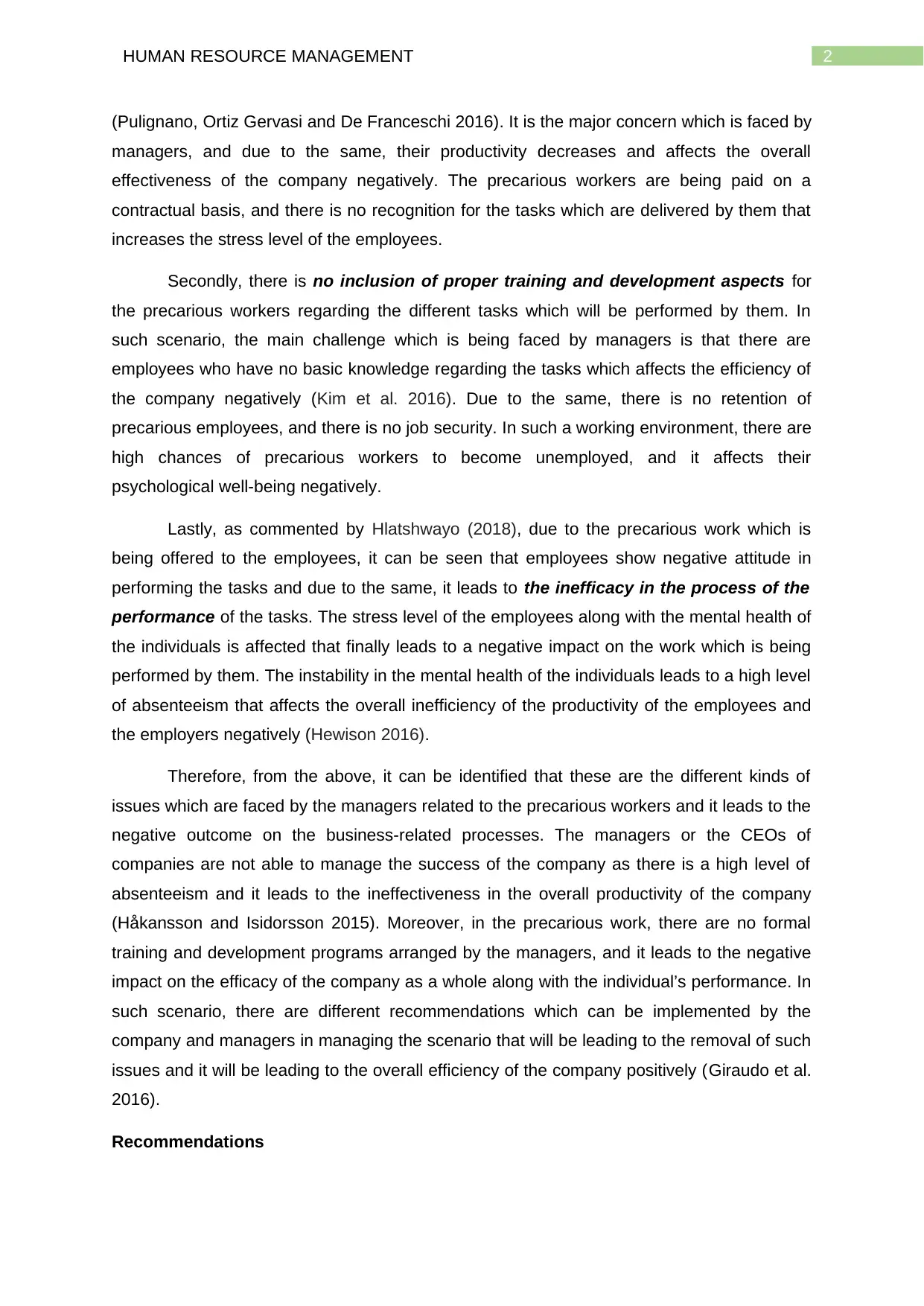
2HUMAN RESOURCE MANAGEMENT
(Pulignano, Ortiz Gervasi and De Franceschi 2016). It is the major concern which is faced by
managers, and due to the same, their productivity decreases and affects the overall
effectiveness of the company negatively. The precarious workers are being paid on a
contractual basis, and there is no recognition for the tasks which are delivered by them that
increases the stress level of the employees.
Secondly, there is no inclusion of proper training and development aspects for
the precarious workers regarding the different tasks which will be performed by them. In
such scenario, the main challenge which is being faced by managers is that there are
employees who have no basic knowledge regarding the tasks which affects the efficiency of
the company negatively (Kim et al. 2016). Due to the same, there is no retention of
precarious employees, and there is no job security. In such a working environment, there are
high chances of precarious workers to become unemployed, and it affects their
psychological well-being negatively.
Lastly, as commented by Hlatshwayo (2018), due to the precarious work which is
being offered to the employees, it can be seen that employees show negative attitude in
performing the tasks and due to the same, it leads to the inefficacy in the process of the
performance of the tasks. The stress level of the employees along with the mental health of
the individuals is affected that finally leads to a negative impact on the work which is being
performed by them. The instability in the mental health of the individuals leads to a high level
of absenteeism that affects the overall inefficiency of the productivity of the employees and
the employers negatively (Hewison 2016).
Therefore, from the above, it can be identified that these are the different kinds of
issues which are faced by the managers related to the precarious workers and it leads to the
negative outcome on the business-related processes. The managers or the CEOs of
companies are not able to manage the success of the company as there is a high level of
absenteeism and it leads to the ineffectiveness in the overall productivity of the company
(Håkansson and Isidorsson 2015). Moreover, in the precarious work, there are no formal
training and development programs arranged by the managers, and it leads to the negative
impact on the efficacy of the company as a whole along with the individual’s performance. In
such scenario, there are different recommendations which can be implemented by the
company and managers in managing the scenario that will be leading to the removal of such
issues and it will be leading to the overall efficiency of the company positively (Giraudo et al.
2016).
Recommendations
(Pulignano, Ortiz Gervasi and De Franceschi 2016). It is the major concern which is faced by
managers, and due to the same, their productivity decreases and affects the overall
effectiveness of the company negatively. The precarious workers are being paid on a
contractual basis, and there is no recognition for the tasks which are delivered by them that
increases the stress level of the employees.
Secondly, there is no inclusion of proper training and development aspects for
the precarious workers regarding the different tasks which will be performed by them. In
such scenario, the main challenge which is being faced by managers is that there are
employees who have no basic knowledge regarding the tasks which affects the efficiency of
the company negatively (Kim et al. 2016). Due to the same, there is no retention of
precarious employees, and there is no job security. In such a working environment, there are
high chances of precarious workers to become unemployed, and it affects their
psychological well-being negatively.
Lastly, as commented by Hlatshwayo (2018), due to the precarious work which is
being offered to the employees, it can be seen that employees show negative attitude in
performing the tasks and due to the same, it leads to the inefficacy in the process of the
performance of the tasks. The stress level of the employees along with the mental health of
the individuals is affected that finally leads to a negative impact on the work which is being
performed by them. The instability in the mental health of the individuals leads to a high level
of absenteeism that affects the overall inefficiency of the productivity of the employees and
the employers negatively (Hewison 2016).
Therefore, from the above, it can be identified that these are the different kinds of
issues which are faced by the managers related to the precarious workers and it leads to the
negative outcome on the business-related processes. The managers or the CEOs of
companies are not able to manage the success of the company as there is a high level of
absenteeism and it leads to the ineffectiveness in the overall productivity of the company
(Håkansson and Isidorsson 2015). Moreover, in the precarious work, there are no formal
training and development programs arranged by the managers, and it leads to the negative
impact on the efficacy of the company as a whole along with the individual’s performance. In
such scenario, there are different recommendations which can be implemented by the
company and managers in managing the scenario that will be leading to the removal of such
issues and it will be leading to the overall efficiency of the company positively (Giraudo et al.
2016).
Recommendations
⊘ This is a preview!⊘
Do you want full access?
Subscribe today to unlock all pages.

Trusted by 1+ million students worldwide
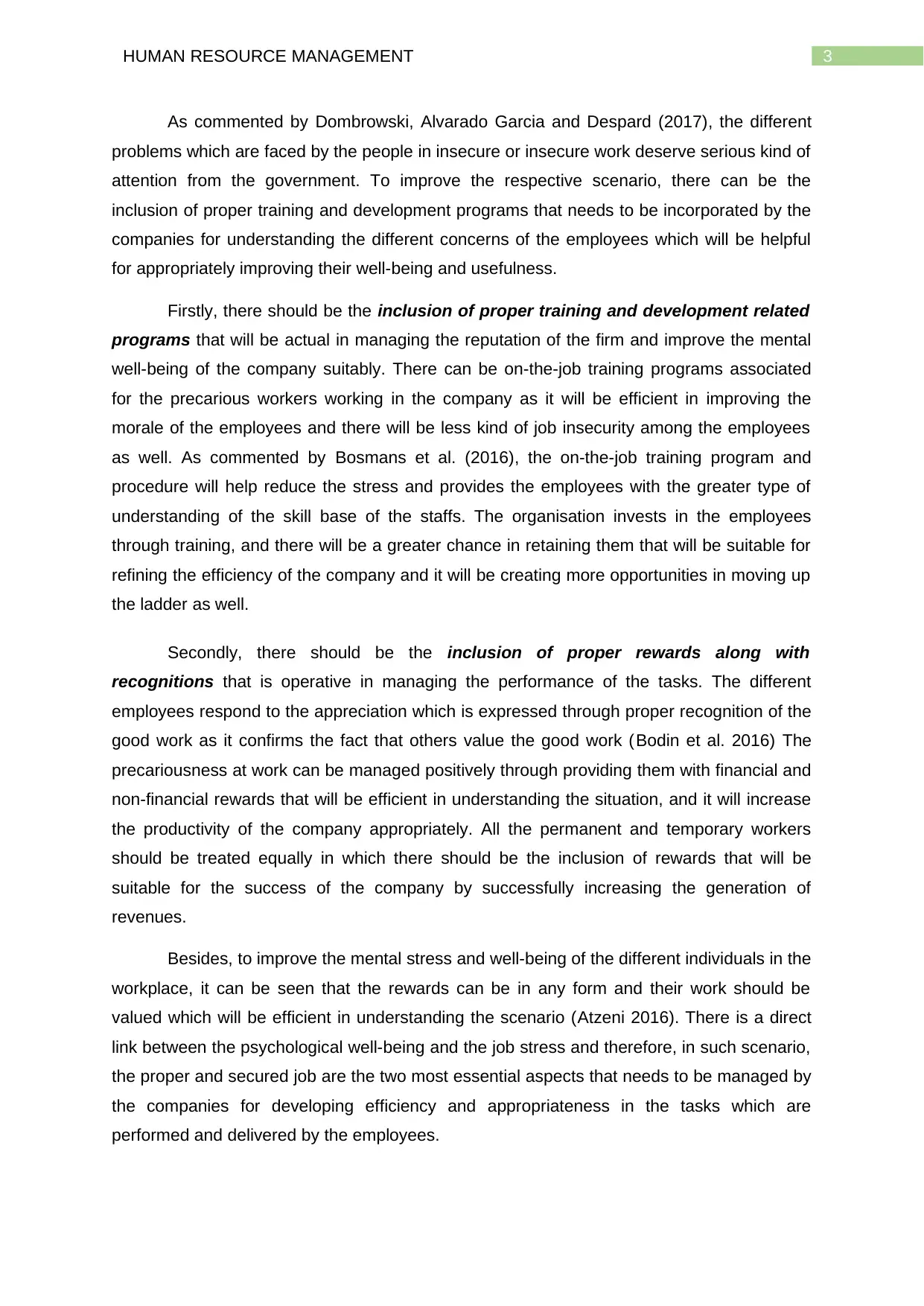
3HUMAN RESOURCE MANAGEMENT
As commented by Dombrowski, Alvarado Garcia and Despard (2017), the different
problems which are faced by the people in insecure or insecure work deserve serious kind of
attention from the government. To improve the respective scenario, there can be the
inclusion of proper training and development programs that needs to be incorporated by the
companies for understanding the different concerns of the employees which will be helpful
for appropriately improving their well-being and usefulness.
Firstly, there should be the inclusion of proper training and development related
programs that will be actual in managing the reputation of the firm and improve the mental
well-being of the company suitably. There can be on-the-job training programs associated
for the precarious workers working in the company as it will be efficient in improving the
morale of the employees and there will be less kind of job insecurity among the employees
as well. As commented by Bosmans et al. (2016), the on-the-job training program and
procedure will help reduce the stress and provides the employees with the greater type of
understanding of the skill base of the staffs. The organisation invests in the employees
through training, and there will be a greater chance in retaining them that will be suitable for
refining the efficiency of the company and it will be creating more opportunities in moving up
the ladder as well.
Secondly, there should be the inclusion of proper rewards along with
recognitions that is operative in managing the performance of the tasks. The different
employees respond to the appreciation which is expressed through proper recognition of the
good work as it confirms the fact that others value the good work (Bodin et al. 2016) The
precariousness at work can be managed positively through providing them with financial and
non-financial rewards that will be efficient in understanding the situation, and it will increase
the productivity of the company appropriately. All the permanent and temporary workers
should be treated equally in which there should be the inclusion of rewards that will be
suitable for the success of the company by successfully increasing the generation of
revenues.
Besides, to improve the mental stress and well-being of the different individuals in the
workplace, it can be seen that the rewards can be in any form and their work should be
valued which will be efficient in understanding the scenario (Atzeni 2016). There is a direct
link between the psychological well-being and the job stress and therefore, in such scenario,
the proper and secured job are the two most essential aspects that needs to be managed by
the companies for developing efficiency and appropriateness in the tasks which are
performed and delivered by the employees.
As commented by Dombrowski, Alvarado Garcia and Despard (2017), the different
problems which are faced by the people in insecure or insecure work deserve serious kind of
attention from the government. To improve the respective scenario, there can be the
inclusion of proper training and development programs that needs to be incorporated by the
companies for understanding the different concerns of the employees which will be helpful
for appropriately improving their well-being and usefulness.
Firstly, there should be the inclusion of proper training and development related
programs that will be actual in managing the reputation of the firm and improve the mental
well-being of the company suitably. There can be on-the-job training programs associated
for the precarious workers working in the company as it will be efficient in improving the
morale of the employees and there will be less kind of job insecurity among the employees
as well. As commented by Bosmans et al. (2016), the on-the-job training program and
procedure will help reduce the stress and provides the employees with the greater type of
understanding of the skill base of the staffs. The organisation invests in the employees
through training, and there will be a greater chance in retaining them that will be suitable for
refining the efficiency of the company and it will be creating more opportunities in moving up
the ladder as well.
Secondly, there should be the inclusion of proper rewards along with
recognitions that is operative in managing the performance of the tasks. The different
employees respond to the appreciation which is expressed through proper recognition of the
good work as it confirms the fact that others value the good work (Bodin et al. 2016) The
precariousness at work can be managed positively through providing them with financial and
non-financial rewards that will be efficient in understanding the situation, and it will increase
the productivity of the company appropriately. All the permanent and temporary workers
should be treated equally in which there should be the inclusion of rewards that will be
suitable for the success of the company by successfully increasing the generation of
revenues.
Besides, to improve the mental stress and well-being of the different individuals in the
workplace, it can be seen that the rewards can be in any form and their work should be
valued which will be efficient in understanding the scenario (Atzeni 2016). There is a direct
link between the psychological well-being and the job stress and therefore, in such scenario,
the proper and secured job are the two most essential aspects that needs to be managed by
the companies for developing efficiency and appropriateness in the tasks which are
performed and delivered by the employees.
Paraphrase This Document
Need a fresh take? Get an instant paraphrase of this document with our AI Paraphraser
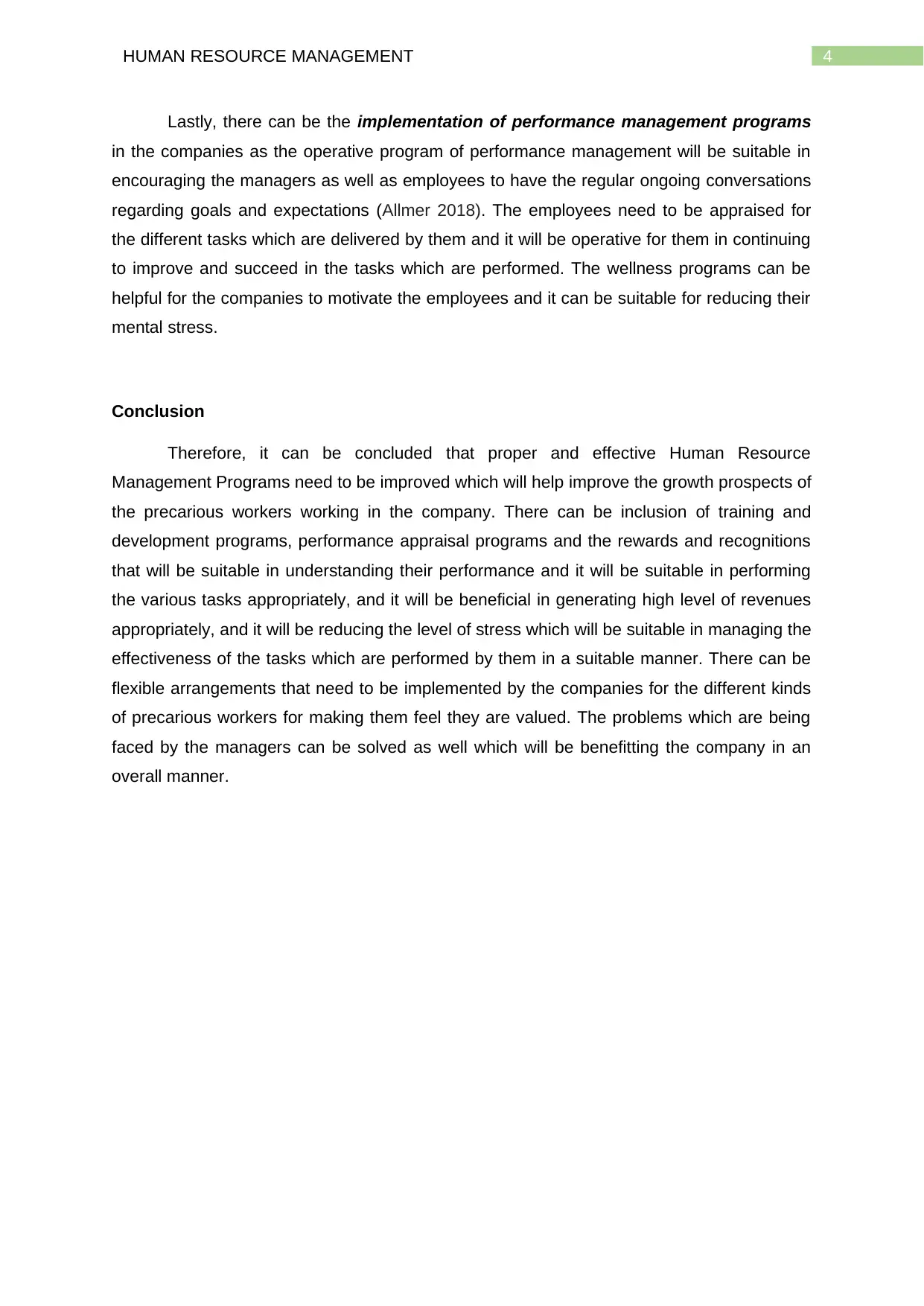
4HUMAN RESOURCE MANAGEMENT
Lastly, there can be the implementation of performance management programs
in the companies as the operative program of performance management will be suitable in
encouraging the managers as well as employees to have the regular ongoing conversations
regarding goals and expectations (Allmer 2018). The employees need to be appraised for
the different tasks which are delivered by them and it will be operative for them in continuing
to improve and succeed in the tasks which are performed. The wellness programs can be
helpful for the companies to motivate the employees and it can be suitable for reducing their
mental stress.
Conclusion
Therefore, it can be concluded that proper and effective Human Resource
Management Programs need to be improved which will help improve the growth prospects of
the precarious workers working in the company. There can be inclusion of training and
development programs, performance appraisal programs and the rewards and recognitions
that will be suitable in understanding their performance and it will be suitable in performing
the various tasks appropriately, and it will be beneficial in generating high level of revenues
appropriately, and it will be reducing the level of stress which will be suitable in managing the
effectiveness of the tasks which are performed by them in a suitable manner. There can be
flexible arrangements that need to be implemented by the companies for the different kinds
of precarious workers for making them feel they are valued. The problems which are being
faced by the managers can be solved as well which will be benefitting the company in an
overall manner.
Lastly, there can be the implementation of performance management programs
in the companies as the operative program of performance management will be suitable in
encouraging the managers as well as employees to have the regular ongoing conversations
regarding goals and expectations (Allmer 2018). The employees need to be appraised for
the different tasks which are delivered by them and it will be operative for them in continuing
to improve and succeed in the tasks which are performed. The wellness programs can be
helpful for the companies to motivate the employees and it can be suitable for reducing their
mental stress.
Conclusion
Therefore, it can be concluded that proper and effective Human Resource
Management Programs need to be improved which will help improve the growth prospects of
the precarious workers working in the company. There can be inclusion of training and
development programs, performance appraisal programs and the rewards and recognitions
that will be suitable in understanding their performance and it will be suitable in performing
the various tasks appropriately, and it will be beneficial in generating high level of revenues
appropriately, and it will be reducing the level of stress which will be suitable in managing the
effectiveness of the tasks which are performed by them in a suitable manner. There can be
flexible arrangements that need to be implemented by the companies for the different kinds
of precarious workers for making them feel they are valued. The problems which are being
faced by the managers can be solved as well which will be benefitting the company in an
overall manner.
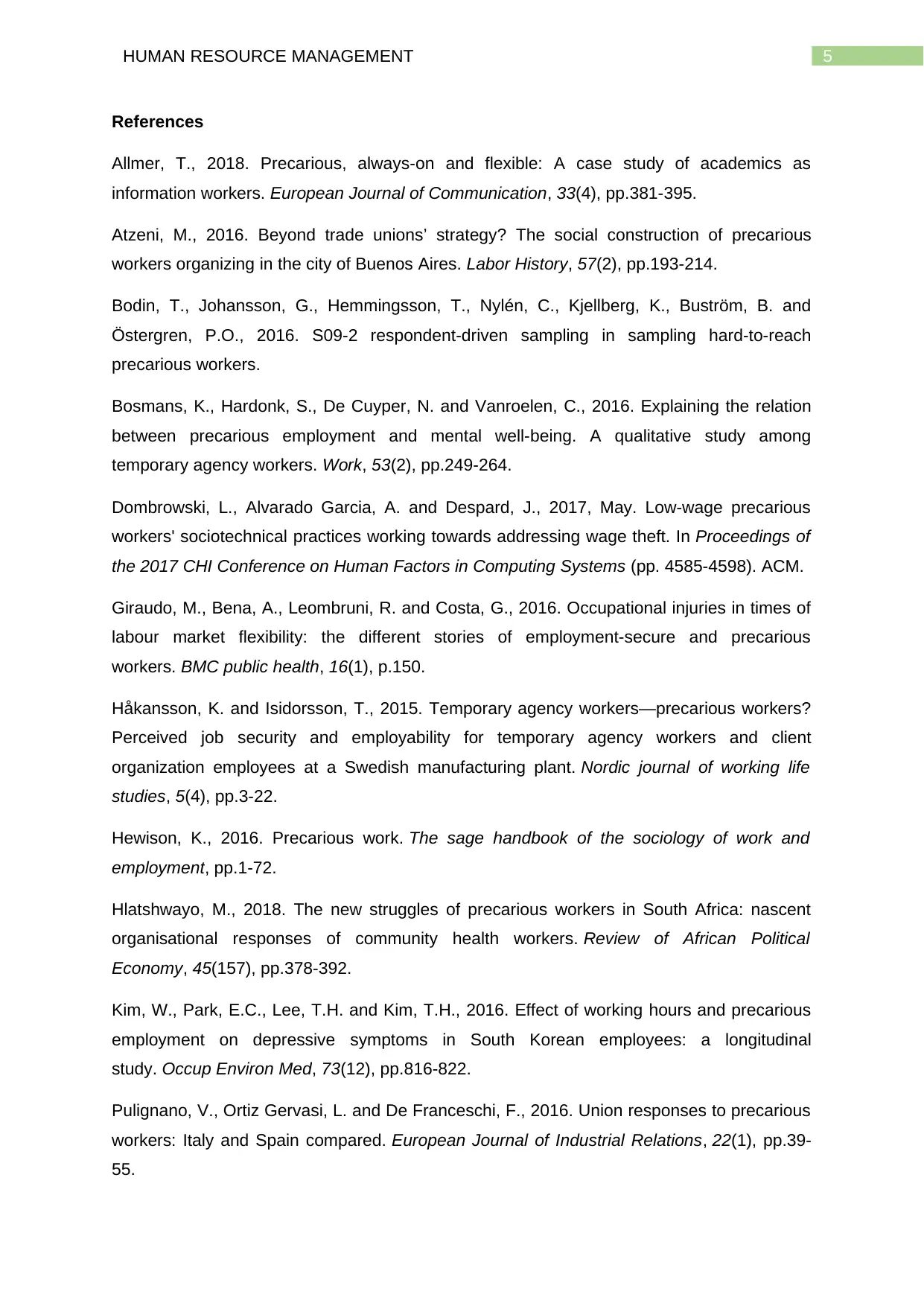
5HUMAN RESOURCE MANAGEMENT
References
Allmer, T., 2018. Precarious, always-on and flexible: A case study of academics as
information workers. European Journal of Communication, 33(4), pp.381-395.
Atzeni, M., 2016. Beyond trade unions’ strategy? The social construction of precarious
workers organizing in the city of Buenos Aires. Labor History, 57(2), pp.193-214.
Bodin, T., Johansson, G., Hemmingsson, T., Nylén, C., Kjellberg, K., Buström, B. and
Östergren, P.O., 2016. S09-2 respondent-driven sampling in sampling hard-to-reach
precarious workers.
Bosmans, K., Hardonk, S., De Cuyper, N. and Vanroelen, C., 2016. Explaining the relation
between precarious employment and mental well-being. A qualitative study among
temporary agency workers. Work, 53(2), pp.249-264.
Dombrowski, L., Alvarado Garcia, A. and Despard, J., 2017, May. Low-wage precarious
workers' sociotechnical practices working towards addressing wage theft. In Proceedings of
the 2017 CHI Conference on Human Factors in Computing Systems (pp. 4585-4598). ACM.
Giraudo, M., Bena, A., Leombruni, R. and Costa, G., 2016. Occupational injuries in times of
labour market flexibility: the different stories of employment-secure and precarious
workers. BMC public health, 16(1), p.150.
Håkansson, K. and Isidorsson, T., 2015. Temporary agency workers—precarious workers?
Perceived job security and employability for temporary agency workers and client
organization employees at a Swedish manufacturing plant. Nordic journal of working life
studies, 5(4), pp.3-22.
Hewison, K., 2016. Precarious work. The sage handbook of the sociology of work and
employment, pp.1-72.
Hlatshwayo, M., 2018. The new struggles of precarious workers in South Africa: nascent
organisational responses of community health workers. Review of African Political
Economy, 45(157), pp.378-392.
Kim, W., Park, E.C., Lee, T.H. and Kim, T.H., 2016. Effect of working hours and precarious
employment on depressive symptoms in South Korean employees: a longitudinal
study. Occup Environ Med, 73(12), pp.816-822.
Pulignano, V., Ortiz Gervasi, L. and De Franceschi, F., 2016. Union responses to precarious
workers: Italy and Spain compared. European Journal of Industrial Relations, 22(1), pp.39-
55.
References
Allmer, T., 2018. Precarious, always-on and flexible: A case study of academics as
information workers. European Journal of Communication, 33(4), pp.381-395.
Atzeni, M., 2016. Beyond trade unions’ strategy? The social construction of precarious
workers organizing in the city of Buenos Aires. Labor History, 57(2), pp.193-214.
Bodin, T., Johansson, G., Hemmingsson, T., Nylén, C., Kjellberg, K., Buström, B. and
Östergren, P.O., 2016. S09-2 respondent-driven sampling in sampling hard-to-reach
precarious workers.
Bosmans, K., Hardonk, S., De Cuyper, N. and Vanroelen, C., 2016. Explaining the relation
between precarious employment and mental well-being. A qualitative study among
temporary agency workers. Work, 53(2), pp.249-264.
Dombrowski, L., Alvarado Garcia, A. and Despard, J., 2017, May. Low-wage precarious
workers' sociotechnical practices working towards addressing wage theft. In Proceedings of
the 2017 CHI Conference on Human Factors in Computing Systems (pp. 4585-4598). ACM.
Giraudo, M., Bena, A., Leombruni, R. and Costa, G., 2016. Occupational injuries in times of
labour market flexibility: the different stories of employment-secure and precarious
workers. BMC public health, 16(1), p.150.
Håkansson, K. and Isidorsson, T., 2015. Temporary agency workers—precarious workers?
Perceived job security and employability for temporary agency workers and client
organization employees at a Swedish manufacturing plant. Nordic journal of working life
studies, 5(4), pp.3-22.
Hewison, K., 2016. Precarious work. The sage handbook of the sociology of work and
employment, pp.1-72.
Hlatshwayo, M., 2018. The new struggles of precarious workers in South Africa: nascent
organisational responses of community health workers. Review of African Political
Economy, 45(157), pp.378-392.
Kim, W., Park, E.C., Lee, T.H. and Kim, T.H., 2016. Effect of working hours and precarious
employment on depressive symptoms in South Korean employees: a longitudinal
study. Occup Environ Med, 73(12), pp.816-822.
Pulignano, V., Ortiz Gervasi, L. and De Franceschi, F., 2016. Union responses to precarious
workers: Italy and Spain compared. European Journal of Industrial Relations, 22(1), pp.39-
55.
⊘ This is a preview!⊘
Do you want full access?
Subscribe today to unlock all pages.

Trusted by 1+ million students worldwide
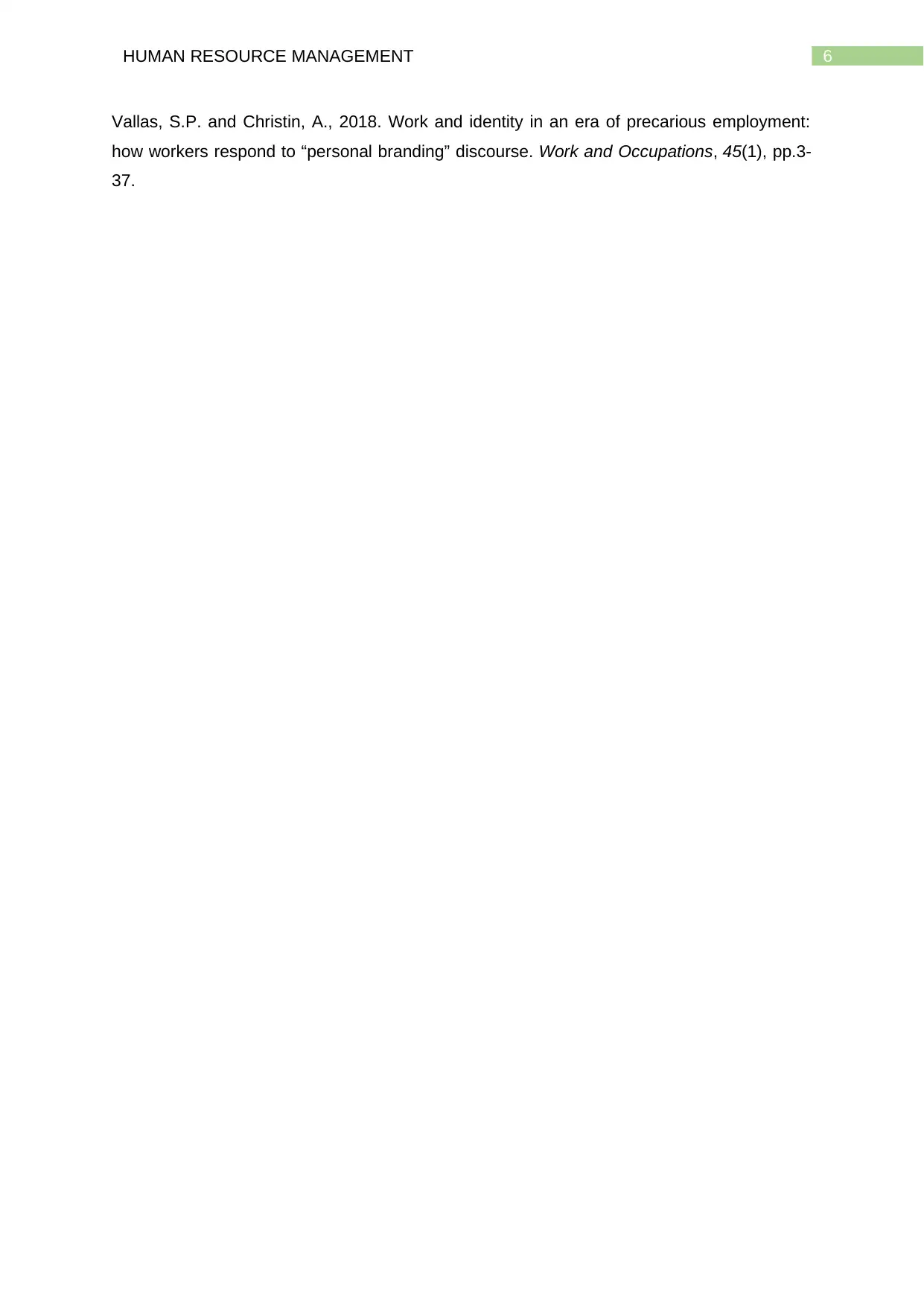
6HUMAN RESOURCE MANAGEMENT
Vallas, S.P. and Christin, A., 2018. Work and identity in an era of precarious employment:
how workers respond to “personal branding” discourse. Work and Occupations, 45(1), pp.3-
37.
Vallas, S.P. and Christin, A., 2018. Work and identity in an era of precarious employment:
how workers respond to “personal branding” discourse. Work and Occupations, 45(1), pp.3-
37.
1 out of 7
Related Documents
Your All-in-One AI-Powered Toolkit for Academic Success.
+13062052269
info@desklib.com
Available 24*7 on WhatsApp / Email
![[object Object]](/_next/static/media/star-bottom.7253800d.svg)
Unlock your academic potential
Copyright © 2020–2025 A2Z Services. All Rights Reserved. Developed and managed by ZUCOL.





